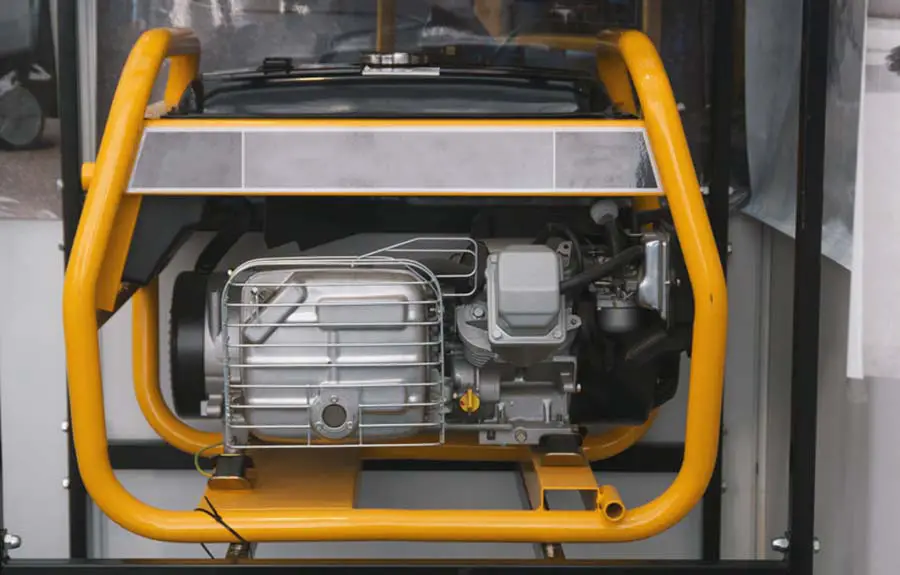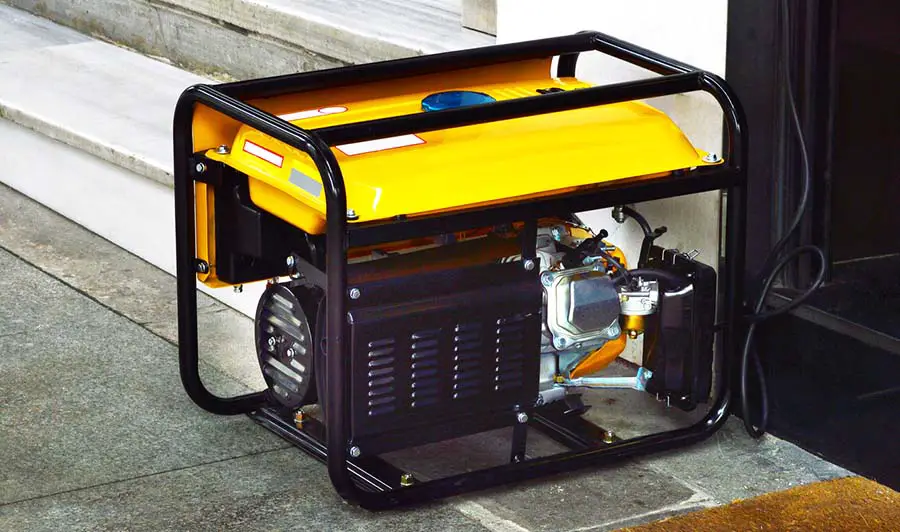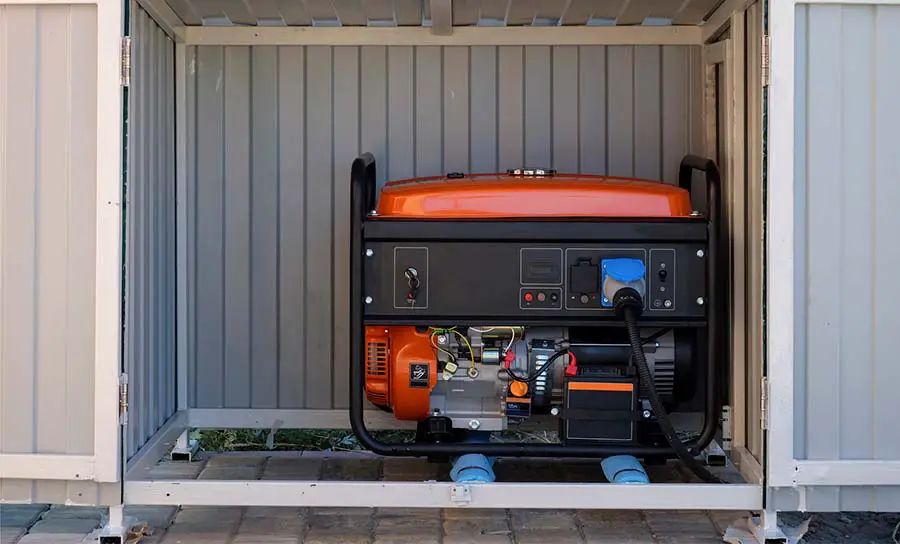
When constantly using a generator, maintenance and servicing the machine is possibly one of the easiest things of owning it. However, in an ideal world, you would not need the generator at all, using it only when camping in the middle of nowhere. Storing a generator for a long-term amount of time can be a challenge, especially when running for a while.
When preparing a generator for long-term storage, you must empty or treat the fuel in the system and replace all the oil filters. Before storing your generator, make sure everything is clean and dry. Keep your generator in a space where it will not sustain damage from other equipment or moisture.
While this may sound easy enough to accomplish, there are multiple steps that you must follow in sequence when storing a generator. Each step ensures that you can continue to use your generator once you’ve removed it from storage. An adequately stored generator can continue working almost immediately once taken out of storage.
Tools Needed to Prepare your Generator for Long-Term Storage
You will need to have a set of basic screwdrivers to loosen most of the smaller pipes when draining the generator. Further, you must have either a ratchet or spanner set to loosen all the bolts, combined with a funnel and a bucket for waste fluids.
These tools will allow you to comfortably and easily open each part of the generator that you will need to. Many people think that servicing or maintaining a generator requires specialized tools like a modern car; however, this is not true. Even the latest automatic generators use basic engine technology you can service with tools bought at a hardware store.
The only thing that you must do that would be unusual is the trip to the nearest automotive parts store to dispose of all the liquids. It is illegal in most countries worldwide to dispose of fuel, oil, and coolants down the drain. You will face severe fines and jail time if you do not dispose of these properly.
How To Prepare a Generator for Long-Term Storage
Let’s take a look at the seven easy steps that you can take to ensure you store your generator correctly so it’s ready to go when you need it.
- Clean and replace the oil and filters
- Remove the gas from teh engine and tank
- Clean the entire generator
- Create a space for the generator
- Move the generator into the space
- Cover the generator for storage
- Avoid damaiging your generator while in storage
1. Clean and Replace the Oil and Filters
You will need to replace the dirty oil in the system by removing the cap that holds the oil into an oil catch pan. Once the oil is empty, replace the oil filter with a new one, refilling the oil once everything has been closed up and not turning it on until you take it out of storage.
Clean oil that sits for too long won’t cause much damage; however, the oil running in your generator is not clean. As the oil settles in your generator while in storage, the suspended metal flakes settle down to the system’s bottom.
2. Remove the Gas From the Engine and Tank
Remove all the fuel from the generator to ensure that the fuel does not expire and clog the engine. You should ensure that there is no gas inside the engine; you can remove this fuel by manually turning the pistons until all the pipes are empty.
You can use a fuel additive for short-term storage of five to eight months. However, as the fuel continues to age, the efficiency and power available will weaken. It may be tricky to accomplish, but your generator will be safer with no fuel in it for long-term storage.
3. Clean the Entire Generator
The main point of dirt entering the system will always be dirt and dust on the generator itself; cleaning this with soapy water and a rag will keep it clean. Before moving the generator, wash every part of the engine, tank, and frame with the rag and soapy water.
It is best to clean your generator to stop any potential dust from entering the system after each use. Before storing it, the best course of action to ensure that nothing causes rust or damage to the outside of the system is by having an entirely clean system.
4. Create a Space for the Generator
Storage space for a generator should be on a flat, even surface away from movement with access to move the generator if needed. Most garages, sheds, or covered areas will be perfect locations for your generator once you’ve thoroughly cleaned the space.
A storage space that can stay unchanged for as long as you need it to be is one of the main reasons people don’t always store their systems. Most people need the space that the generator takes up for other machines or storage containers. Unfortunately, a stored generator will always be a dead space.
5. Move the Generator to the Space You’ve Created
Don’t try to move a medium to a large-sized generator on your own unless it has a wheel system attached to it. It is best to have a friend help you move the generator as this will save your back from damage and prevent the generator from being damaged if it slips.
When you lift the generator, you must lift with your knees, keeping your back straight to allow minimal strain. If the generator is taller than your waist, it is not a portable generator and should be covered and stored right where it is, if possible.
6. Cover the Generator for Long-Term Storage
After moving the generator into its location, you must cover it with protection, either a tightly wrapped plastic sheet or a purpose-built box. The cover should preferably be airtight, watertight, and be removable when needed.
The generator’s cover ensures that you do not have to keep cleaning the machine when dust inevitably gathers on it. Further, the covering keeps bugs, animals, and pests away from the sensitive cables that are in the generator.
7. Avoid Damage to Your Generator While In Storage
Ironically, this is the part many don’t think about; you must ensure that your generator doesn’t sustain damage while in storage. Placing the machine somewhere little traffic or movement takes place will ensure that nothing accidentally falls on top of the machine.
Most generators damaged while in storage have something falling on top of them because someone forgot where they were stored. Ensure that no metal, other machines, or construction materials accidentally fall on the stored generator.
Why Do You Need to Prepare a Generator for Long-Term Storage?

The fluids and dirty areas will heavily damage a generator that is not ready for long-term storage. Oils that should be protecting the generator dry out and settle, clogging systems while the fuel becomes unusable and dried out.
Most generators not ready for storage will almost be unusable as the internal parts have become locked. Usually, this is why you will hear that people had to disassemble their entire generator before using it again. You must take a great deal of care needs to ensure your generator emerges undamaged from the storage.
While there are additives for fuel and oil to make them last longer, these are only meant for short-term storage, around 6 to 12 months. The only fluid that will not completely dry up inside the generator is the oil, which lasts forever if not thinned or processed.
We have learned that you should always prepare a generator for storage. Otherwise, you may as well buy a new one every time you need one.
What If a Generator Is Stored Without Preparation?
If you store a generator without preparation, the fuel inside will become dried out, incapable of being ignited if it is still fluid, with some fuels becoming thick and gelatine-like if left. The oil inside the engine can usually stay liquid unless heated. However, dirty and used oil will be gunky and have metal flakes.
As you place the generator in storage, the dirty filters will also deteriorate inside their housings as the materials become old. Replacing the filters with new filters before storage or plugging their holes will allow you to start the generator easily.
You may see that some generators in long-term storage will have no filters in them and that their air intakes have been closed off. This prevents degradation of the filters and stops dust from entering the system.
How to Start your Generator After Long-Term Storage?
If you have stored the generator properly, you will ensure that everything is clean and ready for when you need to start it. Most people make the mistake of starting the generator without giving it the required work, which you must do even when properly stored.
Every part of the generator is either dry or slightly caked in a layer of oil on the inside. The longer it has been standing still, the more likely it is that you will have to ensure the oil inside can still be used, which is why there are specific steps that you must take before starting the generator.
Replace the Oil In Your Generator
You will need a lot of oil when restarting the generator after taking it out of long-term storage. Depending on how long the generator has been in storage, the current oil may have hardened slightly. You must check on the oil before doing anything else with the generator.
Usually, all you will have to do is remove some of the older oil and add new oil to make sure it is entirely topped up. Usually, this will only require a few liters of oil, with smaller generators only requiring around 2 to 3 liters.
Refill the Fuel In Your Generator
As you have an empty fuel tank and an empty engine, you must refill the fuel tank with fresh fuel meant for the generator. You can do this with your funnel, with engine cleaner added in if you suspect that there was some fuel stuck inside the engine’s pistons.
The fuel amount will depend heavily on your generator’s gas tank; preferably, you should not fill the tank until the generator has started. Always make sure that the fuel you are using is new and the right fuel for the generator for the best possible performance.
Check the Filters In Your Generator
Before refilling the fuel and oil, you must check that the filters are ready, removing the oil filter to ensure nothing is caked, checking the fuel filter to make sure it’s not breaking, and installing a clean air filter. Doing this will ensure that the filters are clean and that the new oil and fuel entering the engine is clean.
We have seen many generators that would have worked properly only fail to operate because the new oil and fuel have flecks of broken filters. If kept dry, you can store these filters for years, but they will start to expire if exposed or used before storing.
Start the Generator
The first start after long-term storage is possibly the most important start for your generator; you will have to ensure that all the fluids and filters are fine before doing it. It is always best to prime the engine properly before starting, with most generators having a priming system built-in.
It will take several turns for the engine to start correctly, usually requiring that you turn the switch multiple times if it is an electric start generator. When using a chain start generator, you will have to pull two to three times before the generator will start, all while using the choke properly throughout.
Difference Between Long Vs. Short-Term Generator Storage

Short-term generator storage can be anything from under 30 days up to a year and requires that you only put additives in the fluids. Long-term storage is when the generator will be stored for longer and will not be used for more than a year, sometimes multiple years.
While many believe that short-term storage is only under 30 days, most generators will not be affected if stored in for this period. Because the batteries on the generators rarely have a constant draw on them, they won’t die, while all the fluids and filters will not be affected by such short-term storage as 30 days.
You must remember that even with all the best additives to the fluids in a generator, the fluids will quickly degrade if stored for more than a year. This is why you need to empty the generator before storing it if you plan on having it packed away for more than a full year.
Best Locations for Storing a Generator Long-Term
Cleaning and storing the generator is much easier said than done once you realize that you constantly use most of the locations in your house. The more foot traffic a location has, the less likely it will be that the generator can be stored there, as the machine will likely sustain damage.
We have learned three locations are perfect for storing a generator, each one offering the generator a safe place away from you. It would help if you learned which of these locations will work best for your generator and how storing them in each will affect how you use it.
Store Your Generator In a Shed
This is the most likely place that people will store their generator, usually because you will have a shed in your garden already aching to have something stored in it. If you have a properly sealed shed and built, you can easily and comfortably store your generator without having to stress about it getting dirty.
If you know that your shed leaks it, that bugs can easily get into it, and that rodents live inside the shed, you should not store it there. Usually, generators less than two years old in storage but look like they are over fifty years old will have been stored in a leaky shed.
Store Your Generator In a Garage
If you live in a typical house, we highly recommend that you store the generator in your garage, where it will be kept safe and away from anything that can hurt it. Garages are usually kept clean, rarely leak, and experience enough foot traffic to keep small animals away.
Garage floors are great locations to store a generator because you will keep it safe even if it is not covered correctly. Many people have found that storing a generator in a garage is their go-to move as it allows the generator to be still easy to reach if needed.
Store Your Generator In a Storage Room
Usually, the last-ditch attempt is when you are unsure of the location in which you want to place your generator. A storage room will require that the generator only gets a sheet placed over it and nothing else, usually because you will have many other things placed in the room.
Storage rooms may not be ideal because of the smell accompanying the generator while it is stored, but it will be an extremely safe place to keep it. We recommend that you still have the generator covered by a shell or plastic wrap to ensure that the generator does not become a sore spot to look at.
Do Not Keep Fuel in a Generator During Long-Term Storage
When stored for longer than six months, several things start happening with gas. First of which is that it loses much of its combustibility due to oxidation. Once it is no longer combustible, the fuel turns into a range of different liquids, each with its properties.
After a few years, most modern gas will become corrosive or turn into a gelatine-like substance at the bottom. The additives we use in modern fuels clump up, becoming more and more as the fuel ages, which is why you will see fuel become dirty if left to age. You must remember this when storing your generator for more than half a year. It is the additives in the fuel already present that causes things to gunk up internally.
We have learned that most people use their generators very infrequently, usually because the people who have them do not need to use them. If you live in an area where you need a generator quite frequently, you will not need to store the generator for the long term. Most western countries have little to no need for generators unless it is in extreme emergencies.
How To Remove the Oil From Your Generator Before Storing
You can use many purpose-built cleaners to remove oil from your generators, usually using a cloth or brush to get into all of the nooks and crannies. However, we recommend unplugging the generator entirely and then using a little bit of gas to clean the covered spots in oil.
It is a little-known fact that gas dissolves most oils, which is why you will see most mechanics quickly cleaning their hands when they finish working. Gas removes oil from any surface that does not absorb it, after which you can wipe away the gas with ordinary soapy water.
It would be best to have the generator unplugged and completely cooled down when doing this, or you may start a fire. As odd as it is, gas has always been a good and easy way to clean off oil from most surfaces to such a degree that few other cleaners can properly measure up.
Conclusion
Your generator does need special care before storing it for a long-term period; you must follow the steps laid out earlier in this article. Further, if you do not follow these steps, your generator can sustain inside and out as its fuel degrades.
Whatever you do, please don’t start your generator simply because you think it may still work, do the necessary steps to clean and prepare it!
